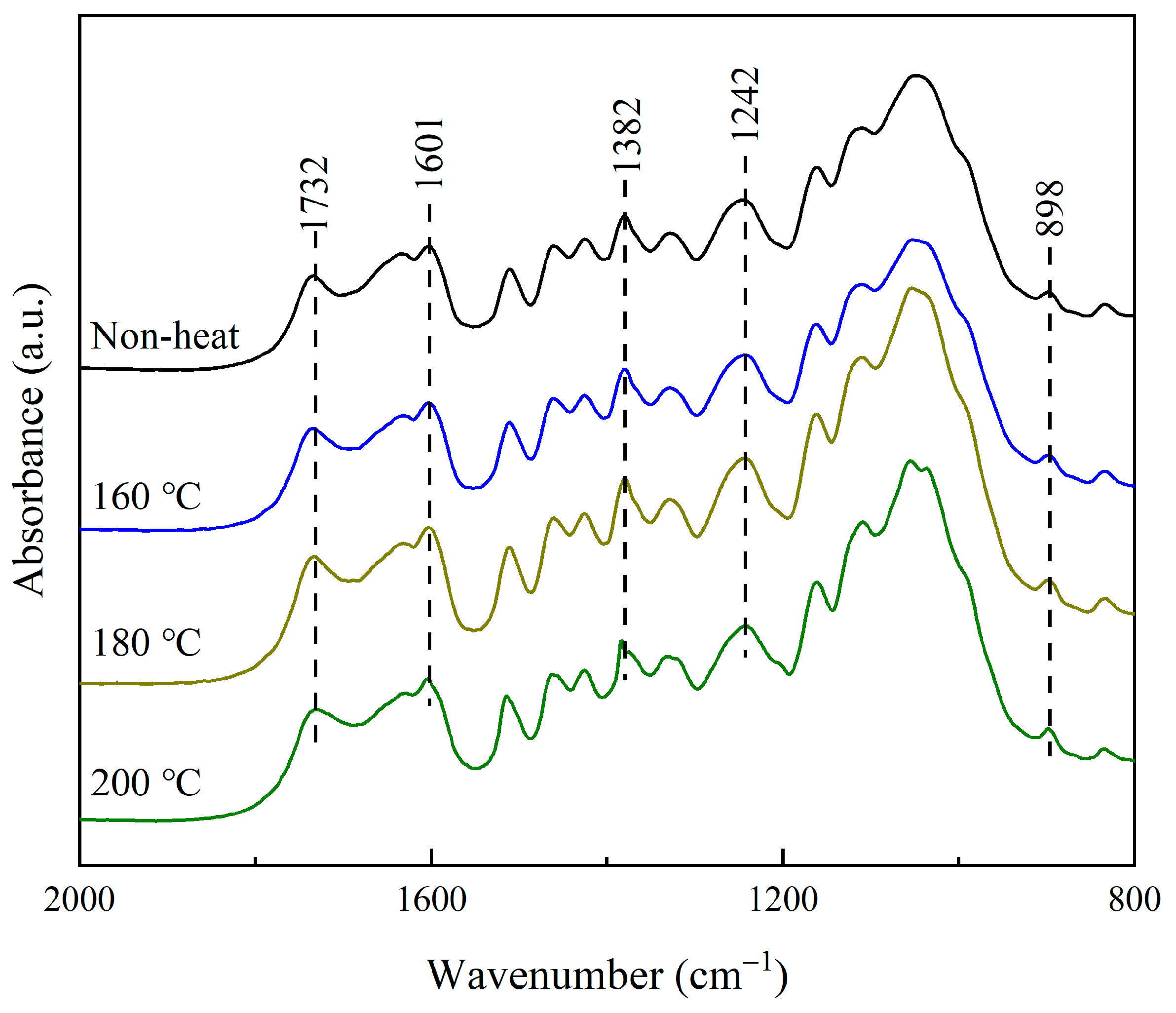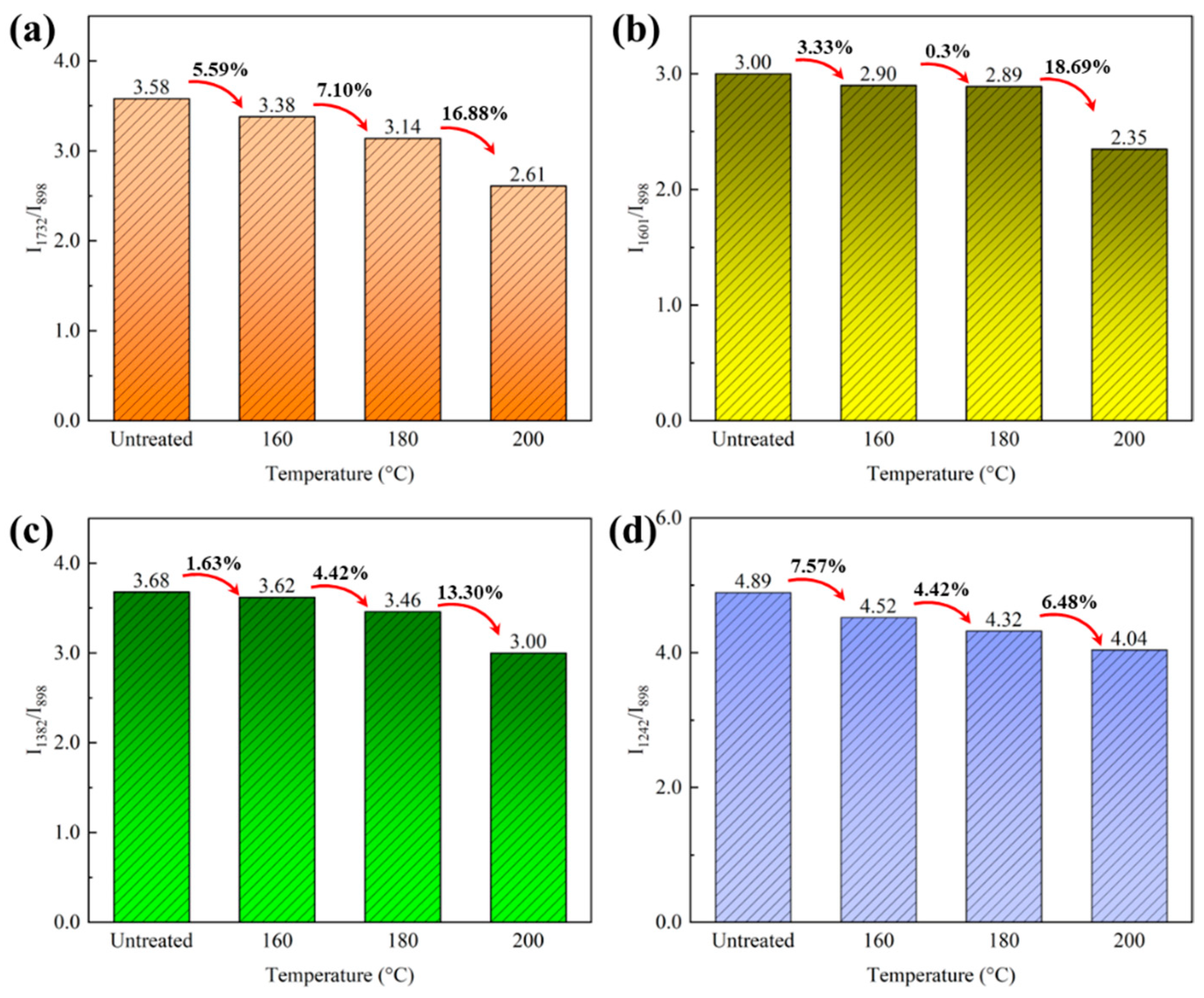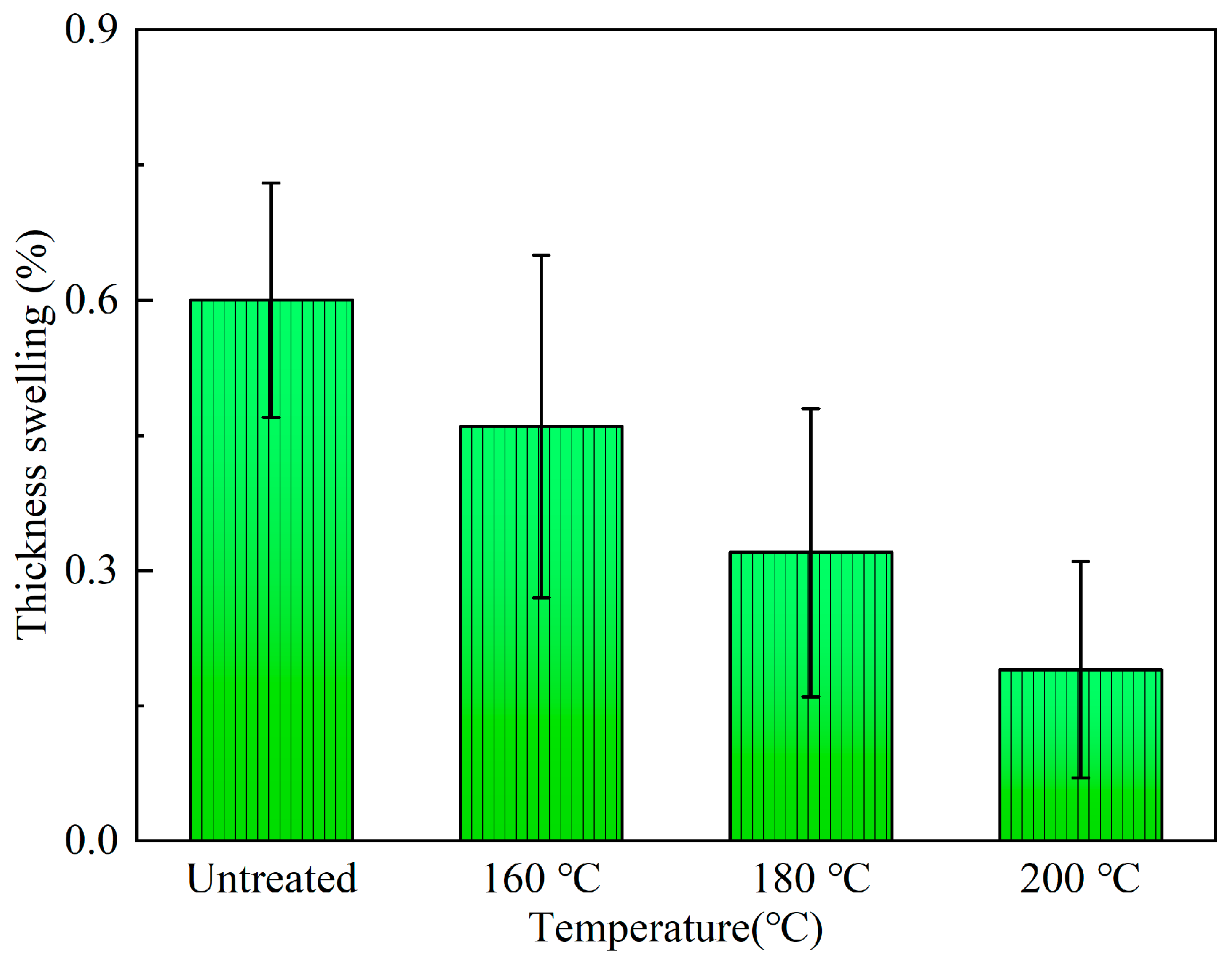Durability Evaluation of Outdoor Scrimbers Fabricated from Superheated Steam-Treated Bamboo Fibrous Mats
Abstract
1. Introduction
2. Materials and Methods
2.1. Materials
2.2. Heat Treatment of Bamboo Fibrous Mats
2.3. Bamboo Scrimber Fabrication
2.4. Mechanical Test
2.5. 28-Hour Heating Cycle Test
2.6. Accelerated Aging Test
2.7. Artificial Weathering Test
2.8. Decay Resistance Test
2.9. Anti-Mildew Test
3. Results and Discussion
3.1. Chemical Analysis of Heat Treated Bamboo
3.1.1. Chemical Composition
3.1.2. Chemical Structure
3.2. Mechanical Properties
3.2.1. Bamboo Scrimbers with Superheated Steam Treatment
3.2.2. Bamboo Scrimbers after Accelerated Aging Test
3.2.3. Bamboo Scrimbers after the Artificial Weathering Test
3.3. Water Resistance
3.3.1. 28-Hour Heat-Moisture Cycle Test
3.3.2. Accelerated Aging Test
3.3.3. Artificial Weathering Test
3.4. Decay Resistance
3.5. Anti-Mildew Properties
4. Conclusions
Author Contributions
Funding
Institutional Review Board Statement
Data Availability Statement
Conflicts of Interest
References
- Harris, N.L.; Gibbs, D.A.; Baccini, A.; Birdsey, R.A.; De Bruin, S.; Farina, M.; Fatoyinbo, L.; Hansen, M.C.; Herold, M.; Houghton, R.A. Global maps of twenty-first century forest carbon fluxes. Nat. Clim. Chang. 2021, 11, 234–240. [Google Scholar] [CrossRef]
- Goonewardena, J.; Ashraf, M.; Reiner, J.; Kafle, B.; Subhani, M. Constitutive Material Model for the Compressive Behaviour of Engineered Bamboo. Buildings 2022, 12, 1490. [Google Scholar] [CrossRef]
- Yu, Y.; Huang, X.; Yu, W. A novel process to improve yield and mechanical performance of bamboo fiber reinforced composite via mechanical treatments. Compos. Part B Eng. 2014, 56, 48–53. [Google Scholar] [CrossRef]
- Meng, F.; Liu, R.; Zhang, Y.; Huang, Y.; Yu, Y.; Yu, W. Improvement of the water repellency, dimensional stability, and biological resistance of bamboo-based fiber reinforced composites. Polym. Compos. 2019, 40, 506–513. [Google Scholar] [CrossRef]
- Huang, Y.; Ji, Y.; Yu, W. Development of bamboo scrimber: A literature review. J. Wood Sci. 2019, 65, 25. [Google Scholar] [CrossRef]
- Liese, W. Research on bamboo. Wood Sci. Technol. 1987, 21, 189–209. [Google Scholar] [CrossRef]
- Chen, Q.; Wang, G.; Ma, X.-X.; Chen, M.-L.; Fang, C.-H.; Fei, B.-H. The effect of graded fibrous structure of bamboo (Phyllostachys edulis) on its water vapor sorption isotherms. Ind. Crop. Prod. 2020, 151, 112467. [Google Scholar] [CrossRef]
- Wu, Z.; Huang, D.; Wei, W.; Wang, W.; Wang, X.A.; Wei, Q.; Niu, M.; Lin, M.; Rao, J.; Xie, Y. Mesoporous aluminosilicate improves mildew resistance of bamboo scrimber with CuBP anti-mildew agents. J. Clean. Prod. 2019, 209, 273–282. [Google Scholar] [CrossRef]
- Cheng, D.; Jiang, S.; Zhang, Q. Mould resistance of Moso bamboo treated by two step heat treatment with different aqueous solutions. Eur. J. Wood Wood Prod. 2013, 71, 143–145. [Google Scholar] [CrossRef]
- Sun, F.; Bao, B.; Ma, L.; Chen, A.; Duan, X. Mould-resistance of bamboo treated with the compound of chitosan-copper complex and organic fungicides. J. Wood Sci. 2012, 58, 51–56. [Google Scholar] [CrossRef]
- Yu, Y.; Liu, R.; Huang, Y.; Meng, F.; Yu, W. Preparation, physical, mechanical, and interfacial morphological properties of engineered bamboo scrimber. Constr. Build. Mater. 2017, 157, 1032–1039. [Google Scholar] [CrossRef]
- Yuan, J.; Fang, C.; Chen, Q.; Fei, B. Observing bamboo dimensional change caused by humidity. Constr. Build. Mater. 2021, 309, 124988. [Google Scholar] [CrossRef]
- Li, Z.-Z.; Luan, Y.; Hu, J.-B.; Fang, C.-H.; Liu, L.-T.; Ma, Y.-F.; Liu, Y.; Fei, B.-H. Bamboo heat treatments and their effects on bamboo properties. Constr. Build. Mater. 2022, 331, 127320. [Google Scholar] [CrossRef]
- Yang, T.-H.; Lee, C.-H.; Lee, C.-J.; Cheng, Y.-W. Effects of different thermal modification media on physical and mechanical properties of moso bamboo. Constr. Build. Mater. 2016, 119, 251–259. [Google Scholar] [CrossRef]
- Wang, X.; Cheng, D.; Huang, X.; Song, L.; Gu, W.; Liang, X.; Li, Y.; Xu, B. Effect of high-temperature saturated steam treatment on the physical, chemical, and mechanical properties of moso bamboo. J. Wood Sci. 2020, 66, 1–9. [Google Scholar] [CrossRef]
- Li, J.; Chen, Y.; Xu, J.; Ren, D.; Yu, H.; Guo, F.; Wu, Z. The influence of media treatments on color changes, dimensional stability, and cracking behavior of bamboo scrimber. Int. J. Polym. Sci. 2018, 1-7, 1–7. [Google Scholar] [CrossRef]
- Shangguan, W.; Gong, Y.; Zhao, R.; Ren, H. Effects of heat treatment on the properties of bamboo scrimber. J. Wood Sci. 2016, 62, 383–391. [Google Scholar] [CrossRef]
- Le, K.H.; Tran, T.T.H.; Tsotsas, E.; Kharaghani, A. Superheated steam drying of single wood particles: Modeling and comparative study with hot air drying. Chem. Eng. Technol. 2021, 44, 114–123. [Google Scholar] [CrossRef]
- Adamski, R.; Siuta, D.; Kukfisz, B.; Mitkowski, P.T.; Szaferski, W. Influence of process parameters in superheated steam drying on fire and explosion parameters of woody biomass. Fuel Process. Technol. 2021, 211, 106597. [Google Scholar] [CrossRef]
- Feng, Q.; Huang, Y.; Ye, C.; Fei, B.; Yang, S. Impact of hygrothermal treatment on the physical properties and chemical composition of Moso bamboo (Phyllostachys edulis). Holzforschung 2021, 75, 614–625. [Google Scholar] [CrossRef]
- Poncsák, S.; Kocaefe, D.; Bouazara, M.; Pichette, A. Effect of high temperature treatment on the mechanical properties of birch (Betula papyrifera). Wood Sci. Technol. 2006, 40, 647–663. [Google Scholar] [CrossRef]
- Hakkou, M.; Pétrissans, M.; Zoulalian, A.; Gérardin, P. Investigation of wood wettability changes during heat treatment on the basis of chemical analysis. Polym. Degrad. Stab. 2005, 89, 1–5. [Google Scholar] [CrossRef]
- Windeisen, E.; Strobel, C.; Wegener, G. Chemical changes during the production of thermo-treated beech wood. Wood Sci. Technol. 2007, 41, 523–536. [Google Scholar] [CrossRef]
- Hao, X.; Wang, Q.; Wang, Y.; Han, X.; Yuan, C.; Cao, Y.; Lou, Z.; Li, Y. The effect of oil heat treatment on biological, mechanical and physical properties of bamboo. J. Wood Sci. 2021, 67, 1–14. [Google Scholar] [CrossRef]
- Zhang, Y.; Yu, Y.; Lu, Y.; Yu, W.; Wang, S. Effects of heat treatment on surface physicochemical properties and sorption behavior of bamboo (Phyllostachys edulis). Constr. Build. Mater. 2021, 282, 122683. [Google Scholar] [CrossRef]
- Shao, Y.T.; Wang, X.Z.; Yan-Jun, L.I.; Yi-Fei, W.U.; Bin, X.U.; Zhang, W.G. Effect of High Temperature Saturated Steam Softening Treatment on Physical and Mechanical Properties of Flattened Bamboo. J. Bamboo Res. 2018, 9, 959–977. [Google Scholar] [CrossRef]
- Zhang, Y.M.; Yu, Y.L.; Yu, W.J. Effect of thermal treatment on the physical and mechanical properties of Phyllostachys pubescen bamboo. Eur. J. Wood Wood Prod. 2013, 71, 61–67. [Google Scholar] [CrossRef]
- Tang, T.; Chen, X.; Zhang, B.; Liu, X.; Fei, B. Research on the physico-mechanical properties of moso bamboo with thermal treatment in tung oil and its influencing factors. Materials 2019, 12, 599. [Google Scholar] [CrossRef]
- Rao, F.; Ji, Y.; Li, N.; Zhang, Y.; Chen, Y.; Yu, W. Outdoor bamboo-fiber-reinforced composite: Influence of resin content on water resistance and mechanical properties. Constr. Build. Mater. 2020, 261, 120022. [Google Scholar] [CrossRef]
- Tang, T.; Zhang, B.; Liu, X.; Wang, W.; Chen, X.; Fei, B. Synergistic effects of tung oil and heat treatment on physicochemical properties of bamboo materials. Sci. Rep. 2019, 9, 12824. [Google Scholar] [CrossRef]
- Qi, H.; Cheng, W.; Liu, Y. Mechanical characteristics and chemical compositions of superheated steam-treated wood under high temperatureand pressure. Dongbei Linye Daxue Xuebao (J. Northeast For. Univ.) (China) 2005, 33, 44–46. [Google Scholar] [CrossRef]
- Xiang, E.; Feng, S.; Yang, S.; Huang, R. Sandwich compression of wood: Effect of superheated steam treatment on sandwich compression fixation and its mechanisms. Wood Sci. Technol. 2020, 54, 1529–1549. [Google Scholar] [CrossRef]
- Yang, H.; Yan, R.; Chen, H.; Lee, D.H.; Zheng, C. Characteristics of hemicellulose, cellulose and lignin pyrolysis. Fuel 2007, 86, 1781–1788. [Google Scholar] [CrossRef]
- Liu, D.; Song, J.; Anderson, D.P.; Chang, P.R.; Hua, Y. Bamboo fiber and its reinforced composites: Structure and properties. Cellulose 2012, 19, 1449–1480. [Google Scholar] [CrossRef]
- Chokshi, S.; Parmar, V.; Gohil, P.; Chaudhary, V. Chemical composition and mechanical properties of natural fibers. J. Nat. Fibers 2022, 19, 3942–3953. [Google Scholar] [CrossRef]
- Chin, S.C.; Tee, K.F.; Tong, F.S.; Ong, H.R.; Gimbun, J. Thermal and mechanical properties of bamboo fiber reinforced composites. Mater. Today Commun. 2020, 23, 100876. [Google Scholar] [CrossRef]
- Krishnan, A.; Xu, L.R. Systematic evaluation of bonding strengths and fracture toughnesses of adhesive joints. J. Adhes. 2011, 87, 53–71. [Google Scholar] [CrossRef]
- Zhang, Y.; Yu, W. Changes in surface properties of heat-treated Phyllostachys pubescens bamboo. BioResources 2015, 10, 6809–6818. [Google Scholar] [CrossRef]
- Zhang, Y.; Huang, X.a.; Yu, Y.; Yu, W. Effects of internal structure and chemical compositions on the hygroscopic property of bamboo fiber reinforced composites. Appl. Surf. Sci. 2019, 492, 936–943. [Google Scholar] [CrossRef]
- Guo, J.; Song, K.; Salmén, L.; Yin, Y. Changes of wood cell walls in response to hygro-mechanical steam treatment. Carbohydr. Polym. 2015, 115, 207–214. [Google Scholar] [CrossRef]











| ML (%) | Decay Resistance Grade |
|---|---|
| 0–10 | I (Strong decay resistance) |
| 11–24 | II (Decay resistance) |
| 25–44 | III (Slightly resistant to decay) |
| >45 | IV (Not resistant to decay) |
| Temperature (°C) | Chemical Composition Change (%) | ||
|---|---|---|---|
| Holocellulose | α-Cellulose | Lignin | |
| 160 °C | −1.39 | −2.73 | 6.77 |
| 180 °C | −2.48 | −9.04 | 11.51 |
| 200 °C | −10.21 | −21.72 | 16.76 |
| Temperature (°C) | White-Rot Fungi | Brown-Rot Fungi | ||
|---|---|---|---|---|
| ML (%) | Decay Resistance Grade | ML (%) | Decay Resistance Grade | |
| Untreated | 5.06 (8.52) 1 | I | 4.46 (14.91) | I |
| 160 | 4.34 (6.82) | I | 3.72 (7.67) | I |
| 180 | 4.12 (9.51) | I | 3.37 (10.91) | I |
| 200 | 3.42 (5.69) | I | 2.71 (7.82) | I |
| Temperature (°C) | T. Harzianum | P. Purpurogenum | A. Fumigatus | B. Theobromae |
|---|---|---|---|---|
| Untreated | 4 | 3.8 | 4 | 4 |
| 160 | 4 | 3.6 | 4 | 4 |
| 180 | 4 | 3.6 | 3.8 | 4 |
| 200 | 4 | 3.5 | 3.8 | 4 |
Disclaimer/Publisher’s Note: The statements, opinions and data contained in all publications are solely those of the individual author(s) and contributor(s) and not of MDPI and/or the editor(s). MDPI and/or the editor(s) disclaim responsibility for any injury to people or property resulting from any ideas, methods, instructions or products referred to in the content. |
© 2022 by the authors. Licensee MDPI, Basel, Switzerland. This article is an open access article distributed under the terms and conditions of the Creative Commons Attribution (CC BY) license (https://creativecommons.org/licenses/by/4.0/).
Share and Cite
Qin, L.; Wei, J.; Bao, M.; Yu, Y.; Yu, W. Durability Evaluation of Outdoor Scrimbers Fabricated from Superheated Steam-Treated Bamboo Fibrous Mats. Polymers 2023, 15, 214. https://doi.org/10.3390/polym15010214
Qin L, Wei J, Bao M, Yu Y, Yu W. Durability Evaluation of Outdoor Scrimbers Fabricated from Superheated Steam-Treated Bamboo Fibrous Mats. Polymers. 2023; 15(1):214. https://doi.org/10.3390/polym15010214
Chicago/Turabian StyleQin, Li, Jinguang Wei, Minzhen Bao, Yanglun Yu, and Wenji Yu. 2023. "Durability Evaluation of Outdoor Scrimbers Fabricated from Superheated Steam-Treated Bamboo Fibrous Mats" Polymers 15, no. 1: 214. https://doi.org/10.3390/polym15010214
APA StyleQin, L., Wei, J., Bao, M., Yu, Y., & Yu, W. (2023). Durability Evaluation of Outdoor Scrimbers Fabricated from Superheated Steam-Treated Bamboo Fibrous Mats. Polymers, 15(1), 214. https://doi.org/10.3390/polym15010214






